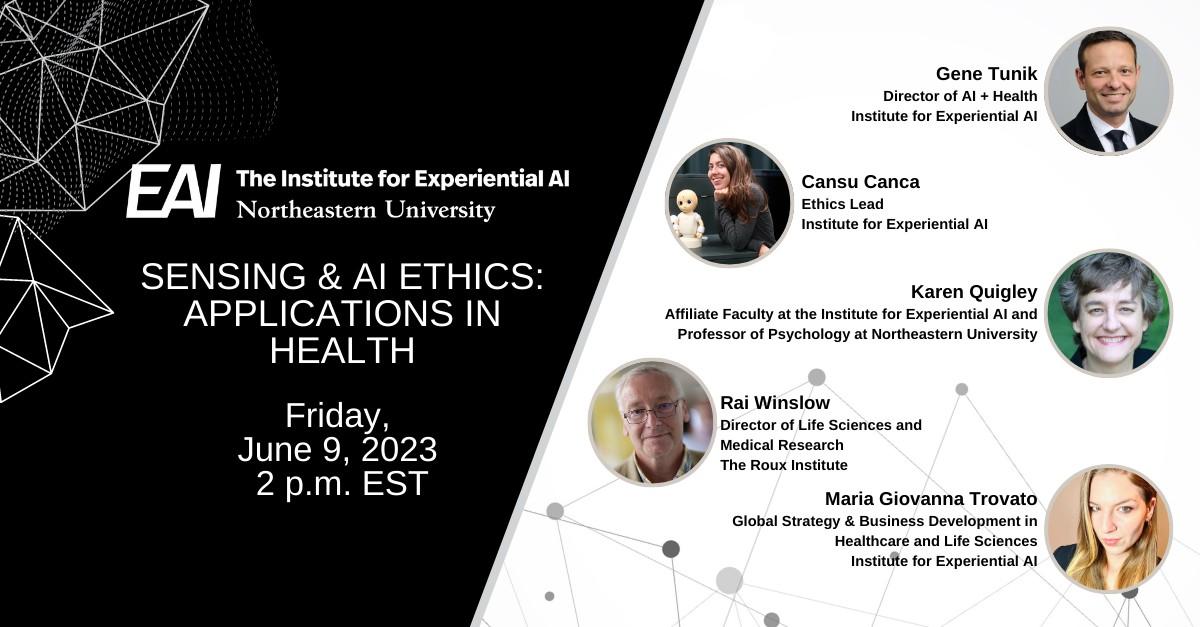


Maria Giovanna Trovato

Business Lead for Health and Life Sciences at the Institute for Experiential AI, Northeastern University






Maria Giovanna Trovato

Business Lead for Health and Life Sciences at the Institute for Experiential AI, Northeastern University


We believe the biggest breakthroughs in the art and science of AI have come—and will come—through applied projects with real-world data that generate tangible results.
The Institute for Experiential AI at Northeastern University researches and develops human-centric AI solutions that leverage machine technology to extend human intelligence.
Successful AI is not ”set it and forget it.” To create real impact, AI must prioritize the human experience and utilize a human in the loop to consistently evaluate and improve its outcomes.
The Institute for Experiential AI exists at



AI has incredible potential to transform human health.
Sensing technology will be critical to reaching that potential.


‘Sensing’ includes technologies like wearables, sleep tracking mats, and motion sensors.

Sensing technologies present incredible potential. And significant risk.
Responsible AI is crucial.





Wearable technology, also known as "wearables," is a category of electronic devices that can be worn as accessories, embedded in clothing, or implanted in the user's body. These devices enable direct interaction between sensors and the end user. They are powered by microprocessors and equipped with the capability to send and receive data via the Internet.







Revolutionizing patient care, diagnostics, and research
Remote Sensing for Health and Healthcare
Wearables and IoT
AI in Diagnostic Medicine

Drug Discovery and Development




Ethics Lead, Institute for Experiential AI Research Associate Professor in Philosophy


Co-Chair, AI Ethics Advisory Board
Director of Research, Institute for Experiential AI
Co-Chair, AI Ethics Advisory Board

 Cansu Canca, Ph.D.
Ricardo Baeza-Yates, Ph.D.
Cansu Canca, Ph.D.
Ricardo Baeza-Yates, Ph.D.
Our RAI services are based on the Puzzle-Solving in Ethics (PiE) Model , developed by the AI Ethics Lab.


The PiE Model lays out four core components of AI ethics implementation: Roadmap, Strategy, Analysis, and Training.



 Gene Tunik Director for AI + Health, Institute for Experiential AI Associate Dean of Research and Innovation at Northeastern University
Gene Tunik Director for AI + Health, Institute for Experiential AI Associate Dean of Research and Innovation at Northeastern University

Accelerating Health and Healthcare Innovation with Human-Centric AI

Global AI + Health practice that spans our 14 campuses spread across 3 countries and 2 continents.














The Challenge:
• Sparse data collection and in the confines of medical visits
The Solution:
• Continuous monitoring offers real-world data about individuals
• Explainable AI models needed to process and interpret large and complex data





Training
Training Data
Model Training
Fractured Hand (accuracy=.89)




Model Output



• Why does it think there’s a fracture?
• Am I missing something?
• Can I correct the error in the AI algorithm?


Fractured Hand
• Fx with displacement
• Ligament disruption

• Mechanism of injury
• Other symptoms
Training Data Explainable Model Model Explanation
● I understand why the AI prediction
● Decision was based on known input data
● I’d like to tweak the model based on learned features

• Note generation from clinicianpatient interactions
• Real-time visualization of salient data

• Visualization of Real World Evidence / Data
• Ecologically-based data labeling






• Smart sampling
• Data compression
• Auto alert to patient / clinician of adverse events







Raimond Winslow Director of Life Sciences and Medical Research

at the Roux Institute. Professor, Northeastern University College of Engineering


HEART Project: Healthcare Enabled
by AI in Real-Time


Data (about patients) Models (of patients) Recommendations (for patients)

In the Cardio-Thoracic ICU (Kramer/ Sawyer/ Winslow)

Monitor Waveforms
Vital Signs
MMC Epic
Advanced prediction of negative outcomes
Feed-back to caregivers
RealTime Comput
Platform




Septic Shock/sepsis
(Median EWT 8 hours)
Liu, R., Greenstein, J. L., Fackler, J. C., Bembea, M.M., Sarma, S. V., Winslow, R. L. (2020). Spectral Clustering of Risk Score Trajectories


Stratifies Sepsis Patients by Clinical Outcome and Interventions
Received. eLife, 2020;9:e58142 DOI: 10.7554/eLife.58142
Pediatric Multiple Organ Dysfunction Syndrome
(Median EWT 37 hours)
PPV 97%
Time Relative to Threshold Crossing (hours)

SN Bose, JL Greenstein, JC Fackler, SV Sarma, RL Winslow, MM
Bembea (2021). Early prediction of multiple organ dysfunction in the pediatric care unit. Frontiers Pediatr. doi: 10.3389/fped.2021.711104




 Karen Quigley Professor of Psychology at Northeastern University Core Faculty, Institute for Experiential AI
Karen Quigley Professor of Psychology at Northeastern University Core Faculty, Institute for Experiential AI
Karen S. Quigley. Ph.D.§ & Lisa Feldman Barrett, Ph.D. §
† *

Northeastern University §


Massachusetts General Hospital †

Harvard Medical School *



The Promise of Wearables for AI + Health is optimized when:
• Data is high-quality, reliable, and multimodal
• Predictive models at the person level, not the group level
• Data is accessible and comprehensible to the user
• Data is secure and protects user privacy

The Promise of Wearables for AI + Health is optimized when:
• Data is high-quality, reliable, and multimodal
• Predictive models at the person level, not the group level
• Data is accessible and comprehensible to the user
• Data is secure and protects user privacy

High-quality, reliable
• Ambulatory physiological monitoring (8 hours/day for 14 days)




• Physiologically-triggered sampling moments (6-8/day)

N = 52 (56% female; M = 22.48 years, SD = 4.38 years)








44 patterns were observed in at least 2 subjects (66%)
1/3 of patterns were unique















The Promise of Wearables for AI + Health is optimized when:
• Data is high-quality, reliable, and multimodal
• Predictive models at the person level, not the group level
• Data is accessible and comprehensible to the user
• Data is secure and protects user privacy





“Gave myself that piece of mind knowing that I don’t have sleep apnea. So, it’s nothing that I should have a concern about being, the numbers being so low. That I’m not even close to like maybe being dangerous. It’s like no, you’re really healthy.”
“It was reassuring that, though I perceive my sleep as being abnormally short, the scientific data says I’m sleeping longer than I think.”



The Promise of Wearables for AI + Health is optimized when:
• Data is high-quality, reliable, and multimodal
• Measures and Algorithms/Models guided by Theory

• Data is accessible and comprehensible to the user
• Data is secure and protects user privacy





Cansu Canca
Ethics Lead at the Institute for Experiential

AI Research Associate Professor in Philosophy

Northeastern University
AI Ethics in Sensing and Wearables: Critical Considerations

Clinician & Researcher

What is the right technology ?
What is the right thing to do?
Hospital & Healthcare system
What is the right health policy?
Clinician & Researcher

AI
What is the right technology ?
What is the right thing to do?
Hospital & Healthcare system
What is the right health policy?
Medical ethics
Public health ethics
Biomedical ethics
Research ethics
Clinician & Researcher

What is the right technology and the right use of it?
Hospital & Healthcare system
Medical ethics
Public health ethics
Biomedical ethics
Research ethics
AI / tech ethics
What is the right thing to do?
What is the right health policy?
Content / product: Developing & designing ethical technologies (AI for Good & Good

AI)
Process: Ensuring ethical processes for tech development
Implementation: Using and implementing tech ethically
Research — Development — Design — Deployment — Update — Monitoring + Procurement (full innovation cycle)
data algorithm tool/UI
practice (HCI)
Content / product: Developing & designing ethical technologies (AI for Good & Good

AI)
Process: Ensuring ethical processes for tech development
Implementation: Using and implementing tech ethically
● data ● user ● user’s environment

● others in relation transparency
● what ● how ● when ● choice? equal outcome
● fairness
● equity accuracy
● define harm
● impact
agency
● HCI
● collaborative decisionmaking
● risk allocation well-being
● impact of information
● individual (user & others)
● societal
● environmental contestability

● expert input
● user input
● data ● user ● user’s environment

● others in relation transparency
● what
● how ● when ● choice? equal outcome
● fairness
● equity accuracy
● define harm
● impact
agency
● HCI
● collaborative decisionmaking
● risk allocation
well-being
● impact of information
● individual (user & others)
● societal
● environmental contestability

● expert input
● user input
agency
● data ● user ● user’s environment

● others in relation transparency
● what ● how ● when ● choice?
● fairness
● equity accuracy
● define harm
● impact
● HCI
● collaborative decisionmaking
● risk allocation well-being
● impact of information
● individual (user & others)
● societal
● environmental contestability

● expert input
● user input







https://aiethicslab.com/big-picture/



informed consent
● online setting
● secondary use of data
● third party models
● withdraw from research

risk & benefit assessment
● minimal risk
● black box
● dual use
● externalities
private information
● re-identification
● group privacy
● data ownership
discrimination / bias
● subject selection
● unrepresentative data
● data with social bias
● proxies
informed consent
● online setting
● secondary use of data
● third party models
● withdraw from research

risk & benefit assessment
● minimal risk
● black box
● dual use
● externalities
private information
● re-identification
● group privacy
● data ownership
discrimination / bias
● subject selection
● unrepresentative data
● data with social bias
● proxies
● Canca & Eto, “AI and Human Subjects
Protection”, CITI Training webinar
● Canca, with Eto & Leong, “AI and Ethics in Human Subjects Research”, CITI Training module

● Eto, with Canca & Leong, “Regulatory
Approaches to AI in Human Subjects
Research”, CITI Training module
● Canca, “Operationalizing AI Principles”, ACM

Communications
● AI Ethics Lab, Dynamics of AI Principles






This slide is an editable slide with all your needs.
Optimize clinical workflow
Enhance accuracy
This slide is an editable slide with all your needs.
Human Centric Approac h



Reduce administrative burden



• Innovation

• Research
• Collaboration
• Ethics
Sensor technology developers




Human Centric Approach
This slide is an editable slide with all your needs.
• Innovation
• Research
• Collaboration
• Ethics
AI algorithm designers
Healthcare Professionals



“If you can dream it, we can help you build it!”



Contact Maria Giovanna at m.trovato@northeastern. edu

Or scan the QR code




